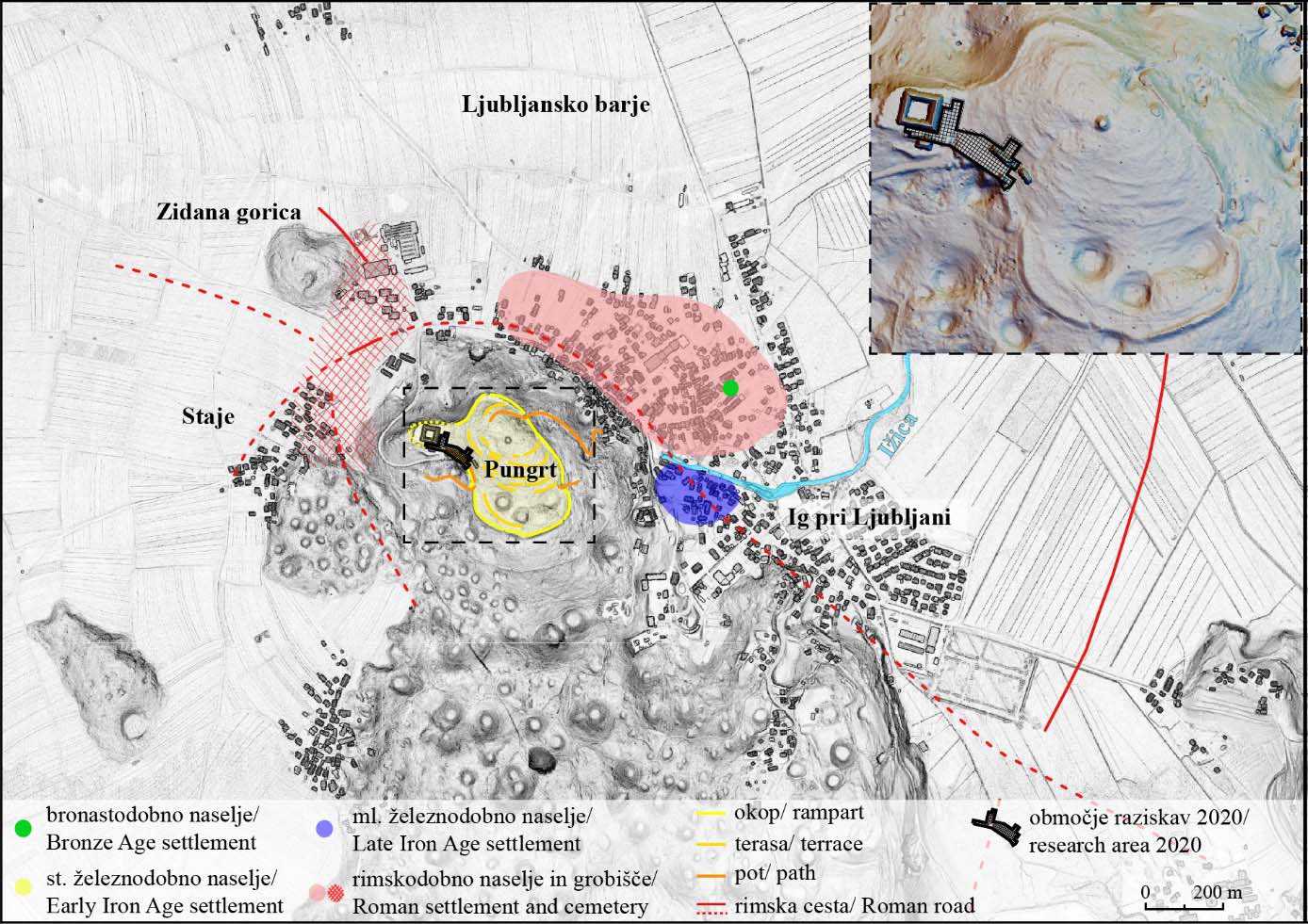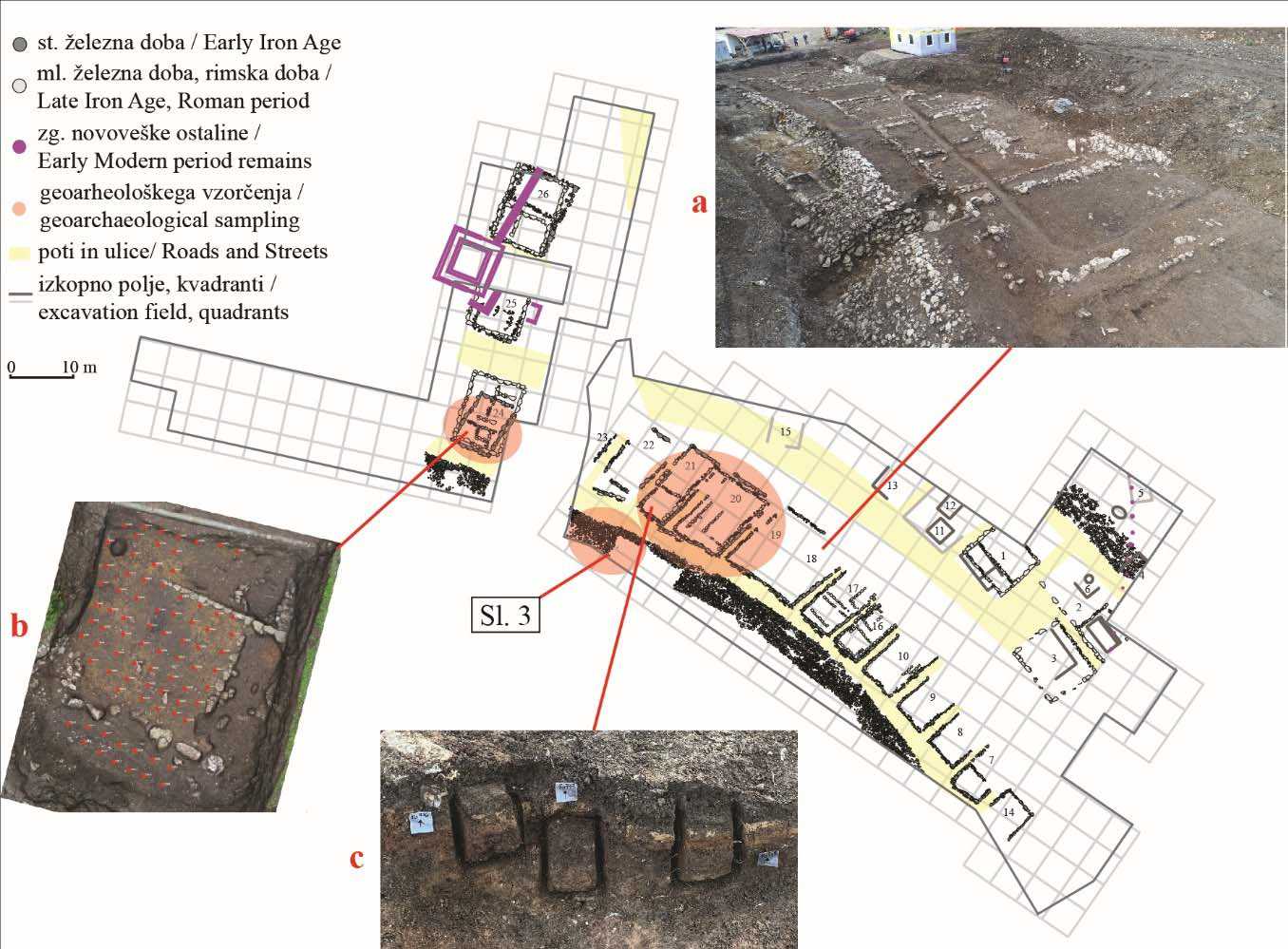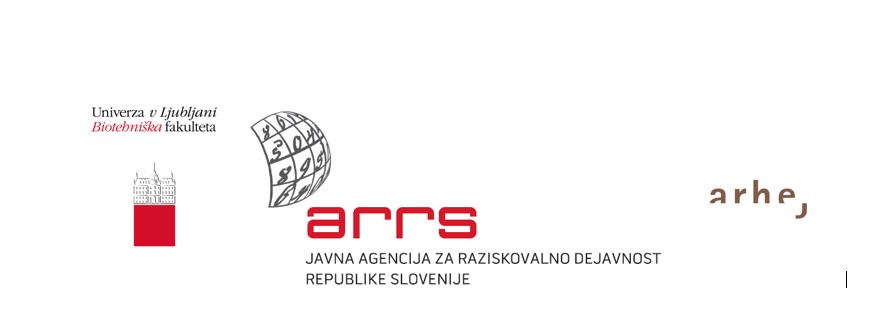

PROJECT SUMMARY
The proto-urban hillfort of Pungrt above Ig: from 10 hectares to 10 microns is an interdisciplinary research project concerned with distinct lifeways at the hillfort and the settlement's long‐term history spanning the Iron Ages and Roman Period. The project is the first in‐depth study of the internal physical, economic and social organisation of any hillfort in Slovenia. Financed by the Slovenian Research Agency, it entails a collaboration of the two University of Ljubljana members with their research centres (i.e. The Faculty of Arts, Department of Archaeology and its Centre for interdisciplinary research in archaeology, and The Biotechnical Faculty, Department of Agronomy and its Infrastructural centre for soil science and environmental protection) and a commercial company with its research‐ development group (i.e. Arhej. d.o.o., Institute for geoarchaeology).
Fortified hilltop settlements (or hillforts) have been essential to the development of Slovenian
archaeology. Their central role within prehistoric landscapes has been revealed through the archaeological research conducted over the past 150 years or more. The discoveries made have included aspects of their material culture, settlement phases and chronology, and their distinct distribution patterns. There is, however, a lack of information regarding their internal physical, economic and social organisation, and the prehistoric lifeways within them.
The proposed research of the Pungrt hillfort represents an important step forward in current hillfort research. Interdisciplinary analyses of the structure of Pungrt’s settlement space, its material culture, and its stratigraphy will enable us to discern, in great detail, single events and recurring activities that took place within the settlement. This approach will also shed light on the settlement's long‐term history spanning some thousand years, beginning at the transition from the 9th to the 8th c. BC and ending in the 2nd c. AD.
By the end of the development‐led archaeological excavation project, the largest continuous area of any hillfort site in Slovenia (8.500 m2) has been uncovered (Figs. 1 and 2). The field research has already revealed several settlement phases spanning from the beginning of the Early Iron Age (9th/8th c. BC) to the Roman Period (2nd c. AD). The orthogonal layout of the buildings, streets and roads, present since its establishment in the Hallstatt Period, make it the first fortified hilltop settlement with a documented proto‐urban design in Slovenia. Adding to the significance of this project is the extensive geoarchaeological sampling programme already in progress at the site. The integration of soil micromorphological analysis of the settlement's micro‐stratigraphy with analyses of micro‐refuse and select geophysical and geochemical signals will enable us to reconstruct past single events and recurring activities within the Pungrt hillfort. Whilst a novel addition to settlement archaeology in Slovenia, the scope of geoarchaeological sampling undertaken at Pungrt for the purpose of research on the settlement stratigraphy is also among the largest in Europe. The extent of the excavation, the large quantity of diverse archaeological material from well‐stratified contexts, and the integrated geoarchaeological approach form, in combination, an extraordinary opportunity for state‐of‐the‐art research into Iron Age and Early Roman Period settlement and chronology.
Figure 1. Settlement history of the Pungrt hill and its vicinity (LIDAR base map). The Pungrt hillfort is also shown on the enlarged LIDAR image (top right). Figure by P. Vojaković.
Figure 2. Plan of the excavated archaeological remains at the Pungrt hillfort. Note the Early Iron Age buildings running in a line next to the rampart (a), geoarchaeological sampling in a grid across different surfaces (b) and in a section (c). Figure by P. Vojaković.
The present research of the proto‐urban hillfort of Pungrt above Ig seeks to fundamentally advance our understanding of distinct lifeways associated with this settlement type. It does so by building upon the solid foundations of, first, the largest stratigraphic excavation of any hillfort site in Slovenia; second, extensive multi‐method geophysical research of both excavated and unexcavated areas of the site; third, a systematic and rigorous sampling programme of indoor and outdoor settlement areas for the purposes of geoarchaeological, archaeobotanical and archaeozoological analyses; fourth, a large collection of recovered artefacts (including pottery from transitional periods); and fifth, a large radiocarbon‐dating programme for samples from well‐defined stratigraphic contexts. The project therefore has great potential for achieving significant scientific discoveries of supra‐regional importance. It also has three specific objectives:
1. The hillfort and its wider setting
The wider setting of Pungrt is an archaeologically rich landscape that has not been the subject of any modern landscape study so far. To fill this gap, the project will combine airborne laser scanning (ALS) or LiDAR imaging with field testing to survey the wider Pungrt. It also aims to employ a number of geophysical methods to investigate different sections of the hillfort interior and exterior, especially those with the best potential for this type of research, such as those places outside the fortified Pungrt area where additional settlement structures and a number of burial grounds might be expected.
2. The socio‐economic biography of the settlement
The various settlement elements that form the focus of this project (i.e. the indoor and outdoor surfaces and structures such as constructed house floors, fireplaces, metallurgic furnaces, streets, paths and the site's fortification system; Figs. 2 and 3) would, in fact, have reflected tradition and change in socio‐economic activities and relations within the community through time. Each activity leaves a micro‐stratigraphic, geochemical and geophysical imprint within the archaeological record, so the applied multimethod geoarchaeological approach (supplemented with archaeobotanical and archaeozoological analyses) allows for the analysis of continuity and change in the structured use of space – either within individual buildings or in outdoor areas, such as streets and roads. By comparing and contrasting these different places inside the hillfort, the project ultimately seeks to reconstruct the settlement’s distinct socio‐economic biography and the different phases in its development.
3. Artefacts, materials, technologies and practices
The project aims to combine typological and chronological studies of select artefacts from well-defined stratigraphic contexts with analyses of their manufacturing technologies. Different aspects of ceramic production and the chronology of pottery manufactured during transitional periods will be clarified and refined using scientific methods such as technological and petrographic analyses. The provenance of various ores and copper alloys used in the production of bronze objects at Pungrt will be traced through spectroscopic analysis. A combination of taxonomic and isotope (C, N, S, O, Sr) analyses of archaeozoological material will be used to discern the diets of animals at Pungrt and their origins in order to better understand the herding practices used at the hillfort during the period of its occupation. Overall, such a dataset will provide in‐depth information on people's skills and the practices and technologies that were employed at Pungrt through time.
The ultimate objective of this research is to profoundly understand a thousand‐year history of the
Pungrt hillfort, its gradual (proto‐)urbanisation, and its distinct role within the wider landscape setting. To achieve such an ambitious goal, a number of distinct datasets will be examined, interpreted and combined. By synthesising excavation data, radiocarbon dates, the results of the specialist analyses of the settlement space, material culture and the site's stratigraphy, we aim to produce a fundamental study on Pungrt's long‐term history. In it, special emphasis will be placed on the analysis of the socio‐economic structuring of the hillfort interior through time. This ground‐breaking analysis will be supported by a comparative study of Pungrt's material culture, spatial organisation, and landscape context with other relevant sites in the area between the south‐eastern Alps and Pannonia.
Assist. Prof. Dr. Matija Črešnar: project director and an expert in the Bronze Age and Iron Age archaeology, with extensive experience in interdisciplinary hillfort research. (Co‐)Director of a number of international, interdisciplinary projects.
Assist. Prof. Dr. Branko Mušič: an expert in archaeological geophysics, with outstanding experience on various complex archaeological sites, including hillforts, in Slovenia and abroad.
Prof. Dr. Helena Grčman: an expert in soil science, with extensive experience in soil science analyses and interpretation of soils and soil forming processes.
Dr. Petra Vojaković: an expert in field archaeology and Bronze and Iron Age archaeology, with considerable experience in research and interpretation of the proto‐urban sites. A field director of the archaeological excavation at the Pungrt hillfort.
Agni Prijatelj, MA in archaeology: a doctoral candidate at Durham University, specialising in geoarchaeology, including soil/sediment micromorphology and complementary geophysical and geochemical analyses.
Assist. Luka Gruškovnjak, MA in archaeology: a doctoral candidate at the University of Ljubljana, specialising in archaeological methodology and geoarchaeology, and statistical and spatial (GIS) analyses.
Assist. Dr. Manca Vinazza: expert in ceramic material typology, technology and petrography analyses and in the Bronze Age and Iron Age archaeology.
PHOTO ALBUM
financiers and partners


